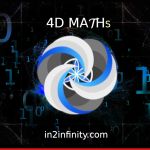Okay, welcome, everyone. My name is colin power from in2infinity is a little bit of a supplementary broadcast. I just had a few numbers about that. A few questions about the prime number stuff from the last broadcast. Let’s just recap. We, if you followed the last broadcast, we got down to a grid of six numbers 1920 830-755-7391. And what you notice there? Yes, those are some people saying he was there’s no kind of a symmetry there. Except obviously with number 55 and 28. Now, obviously if you add to an eight together, you get 10, five and five, you get 10 one and nine, you get 10. Yeah, they all add up to 10, which is that that number we’re looking for working in base 10. So that means we want to be working with that number. But date 10 can be split, you know what I mean in a number of ways. And what we’ve done is cover most of the bases and which ways in which you can be split in here and these numbers, but also what he identifies is that number two, eight and five, five, really when we talk about it as a number as a number itself, you know, what we should really look at is those are going to be coming from the five and the two. And so as we’re probably not going to be having those numbers in higher primes, we can kind of almost let’s draw a circle around those. Yeah, so we draw a circle around 28, circle 35. And that singles them out a little bit. And what does that leave us with? Well, if you think about it, that means I can write let’s say, let’s write the number 19. Then as a dot with a space, and I’m going to write the number 37 Next. Now let’s write the number 73. And what sorry, 37 And then there’s another dot isn’t there? Sorry. And then there’s 73. Yeah. And then there’s 91. So you can see there’s a kind of symmetry here, around that second dot, which is the five you know, where we have one set here, which is 1937, which is divided by a dot, which is the number two. And then we have a whole set here, which is one whole set and now the dot exists between the three and seven second type of dots, two types of decimal place. So what we see there then is like this perfect mirror image, don’t we? Yeah, it’s like the reflection point we found. So imagine what we were talking remember we talked about an F naught point five. And you can imagine here 1937 We have a zero point in the middle let’s just consider those as like a thing for a second one thing you know, there’s been divided and let’s look at the number 7391. And what happens is 7391 is made another half and that’s been divided and in is 1973. forms this perfect mirror reflection, doesn’t it? Yeah. So looking at this 1239 to seven ratio. All we have here is that as you add those numbers together, you begin to create the number 16 with the nine and the seven as the one and a six, you see is a bit of a strange number that isn’t it? Yeah, because you’re going up boom, into something bigger six. Yeah. And, and the six shouldn’t really appear, but it does. You know, that’s where does it come from? Well, it must come from that function. Yeah. And then when we look at the number one and three becomes four, well, that’s to prepare you That’s politics, isn’t it? But it does and so we can say, oh, maybe it’s part of that function, you know. Whereas on the other hand, when one meets one, nine meats, nine, then three meats, three, seven meats, seven, that’s what we call a zero balance between the two. The two number forms. Yeah. And so what we can do is, we can set up if you like a kind of number mirrors, if you like in space in 4d, and we can create these mirrors and they can reflect. You can set a mirror point, let’s say we set a mirror point for 1937 7391. And what we’ll do is just know when do we find the evens, even point, the breakpoint, there’s even, and then we have like 1937 And there’s a breakpoint between there. And then what we’re really going to look at there is, you know, where do we get them? Is there any number sixes, for example, we’ll look at the number, the result of the number. Is there a number six, you know, we can start decode from that way. And so we can go decode all of the numbers one by one, and eventually get down to a sensible answer as to what the actual result really is, once we make the numbers all into number pairs, and then we can just unpair them to do that, and we roll it all the way back down. And we should find that we get at least somewhere near the result anyway, so and that’s close enough for us to sort of give us a good idea about how we can look at prime numbers in a different kind of way. So remember that all the primes are about it above the double digits. This is the key here.
Sorry, under the double digits, the two and the five will eliminate everything that ends with five because we’re in base 10 The answer that that’s just a distortion of base 10. You know, that’s just how you say it, but it does mean that that rough distortion will reflect through the whole number sequence. So that means you won’t get these numbers or apparent numbers as a chord you know, with ending with the number five because it’s all 555555050 all on the five times table isn’t it is taken out all of those numbers. But when we come to the numbers like three and things like that, because they don’t need to face the base 10 In the same kind of way, what we find is that there’s a there’s a kind of like when it bounces from one to the other. It’s kind of like when you divide that string between two and three, you know that you could divide it into two define when you divide into three get this infinity of threes, and that’s and that’s really what’s what’s creating this particular function where we have got this beat that’s that that’s that actually the root of based in distortion. And so once we know that’s the root, what we can do is we can we can start to sort of say okay, well isn’t this mega map if you like, of the main prime numbers, the will always be ending in either 137 or nine, we can only be one of those four numbers, which removes pretty much a lot of the numbers out of existence, if you think about it, if a number can only end in a base 10 number, and that from that we can work out a little bit about prime number density in relation to base 10. You know, it’s any base 10 prime number density, it’s not an infinite. And so and then that but that’s not that’s not bad, because based in prime numbers, densities are useful. Definitely very useful. So you know, but that’s how we can work some of that stuff out, you know, how we start to look at it from the other way around. So I hope there’s been a little bit of inspiration on some of the prime numbers stuff and about those prime dual digit prime numbers that we were talking about and, and the process of creating, like kind of bounce points in numbers that reflect off each other and reveal stuff about the number itself. And that’s how we kind of can work in 4d by creating these kind of maps, you know, number maps and fourth dimension, you know, anyway, that’s all it’s all to play for at the moment, as a plenty of cool stuff. And water fourth dimensional mathematics as you can imagine, very much exciting. Time for mathematics, I feel and if you want to get involved Yeah, dude, please fit it into infinity.com and sign up to the mailing list. We’d love to hear from you and get all your feedback and all that sort of stuff in the comments and all that business. In the meantime, my name is Colin Power. You guys are awesome. Have a fantastic day.


